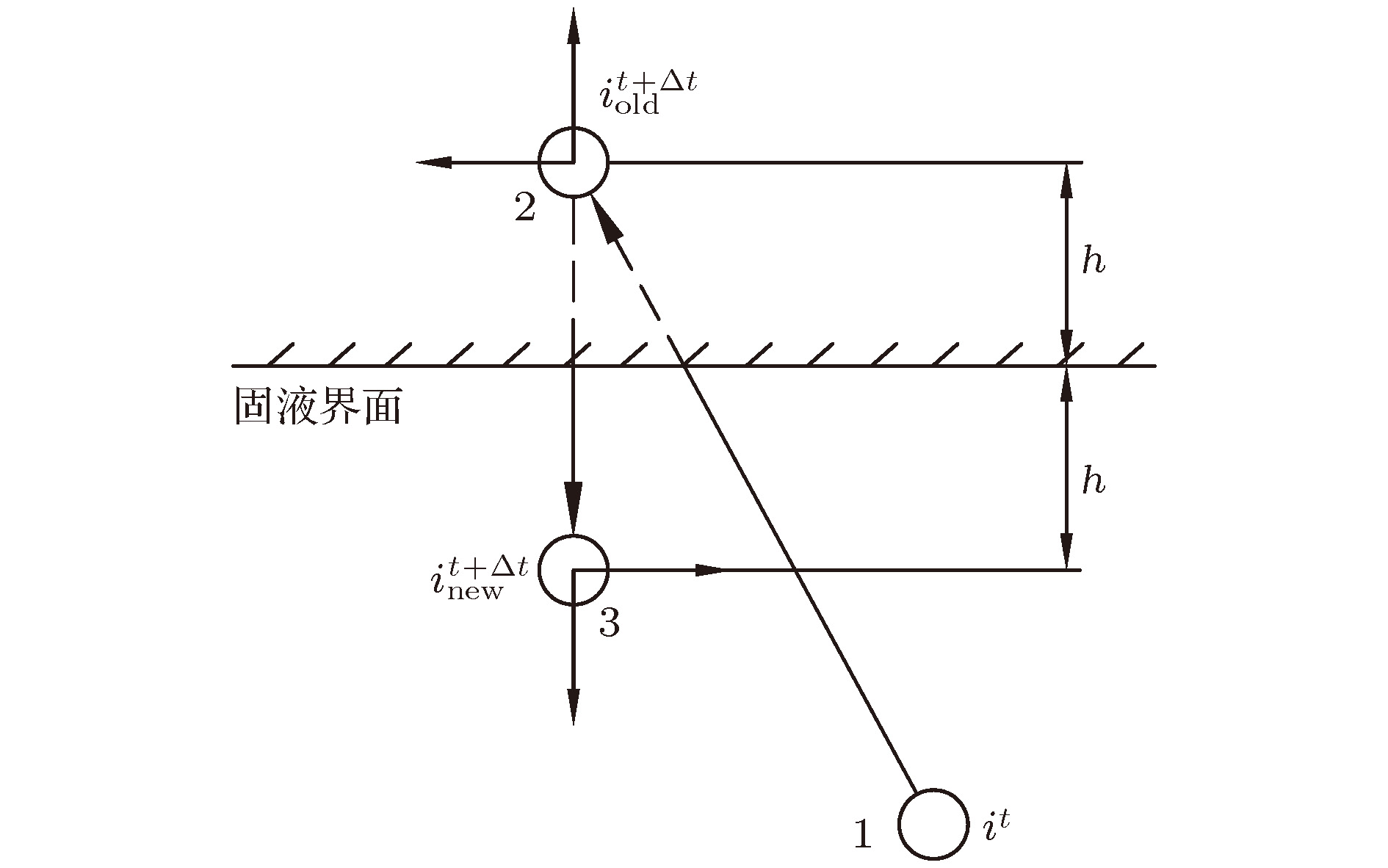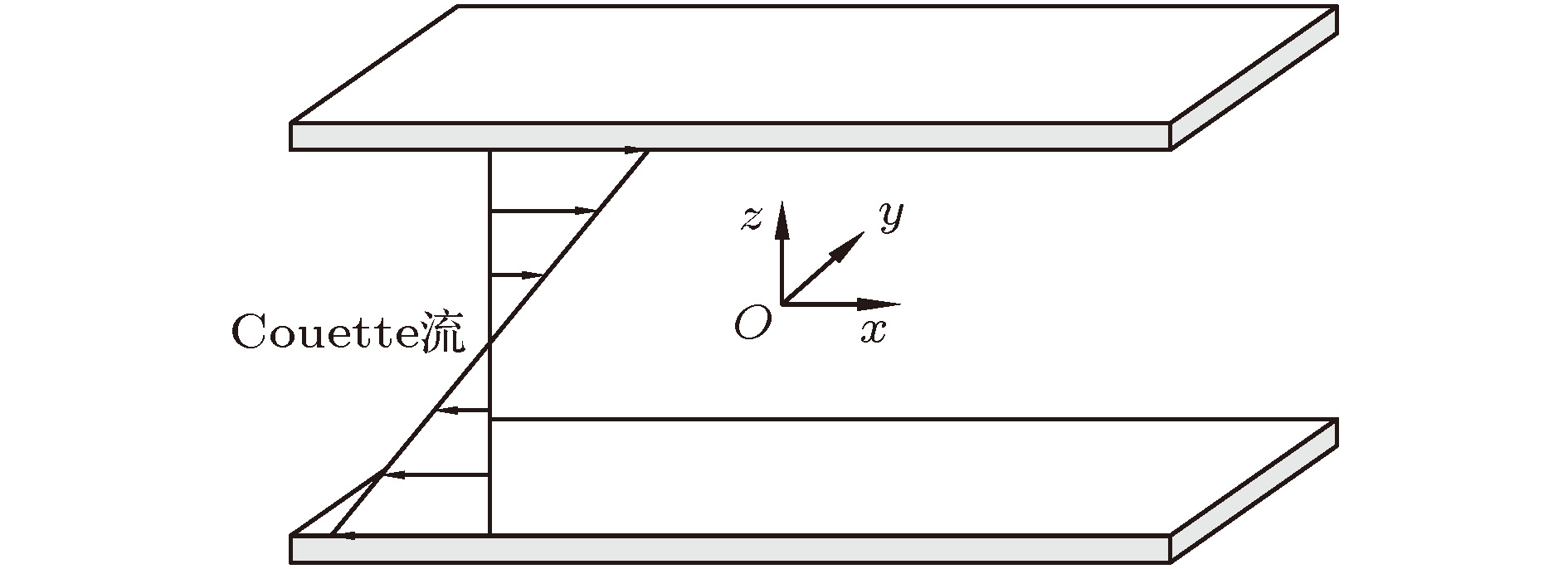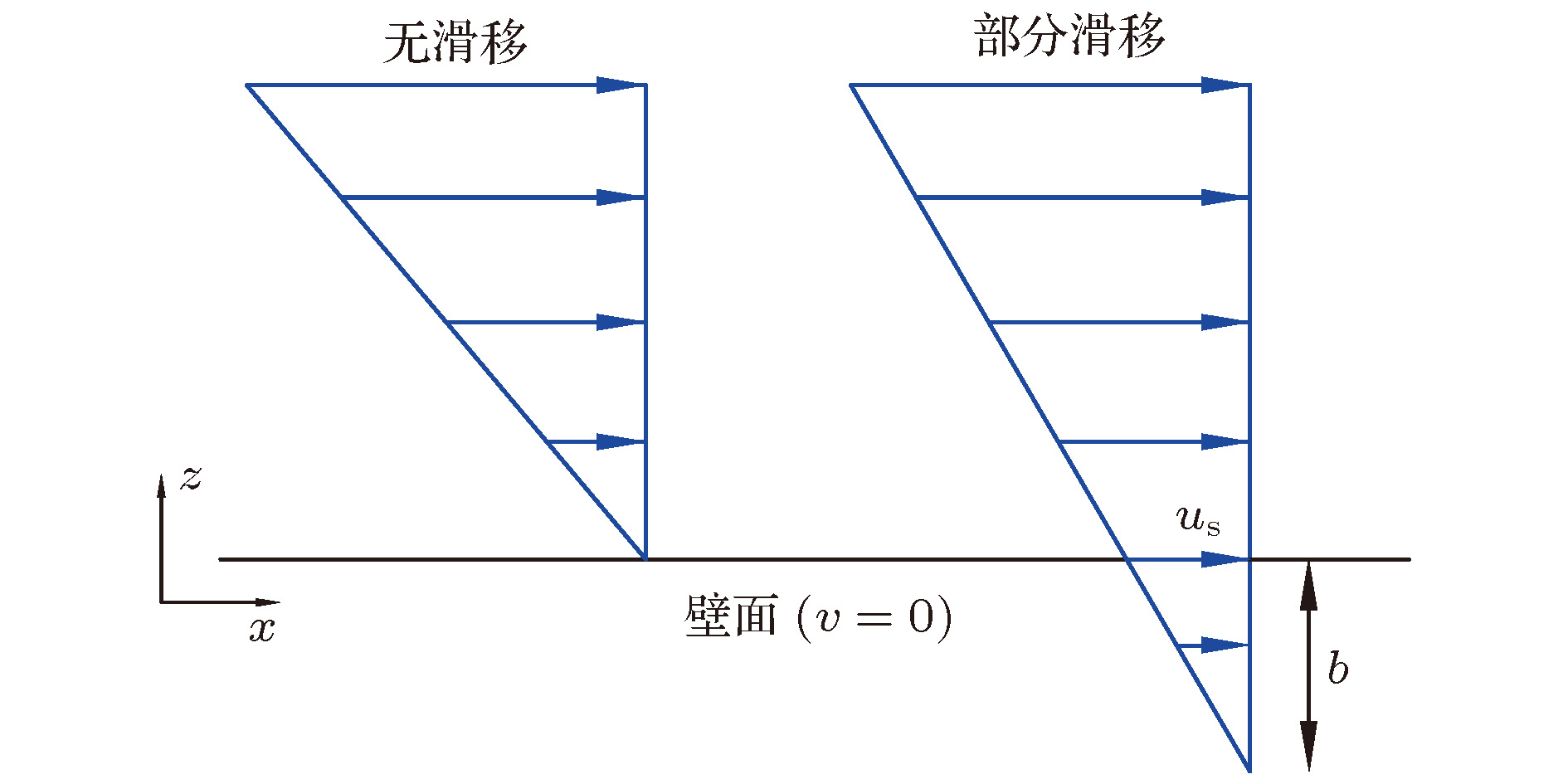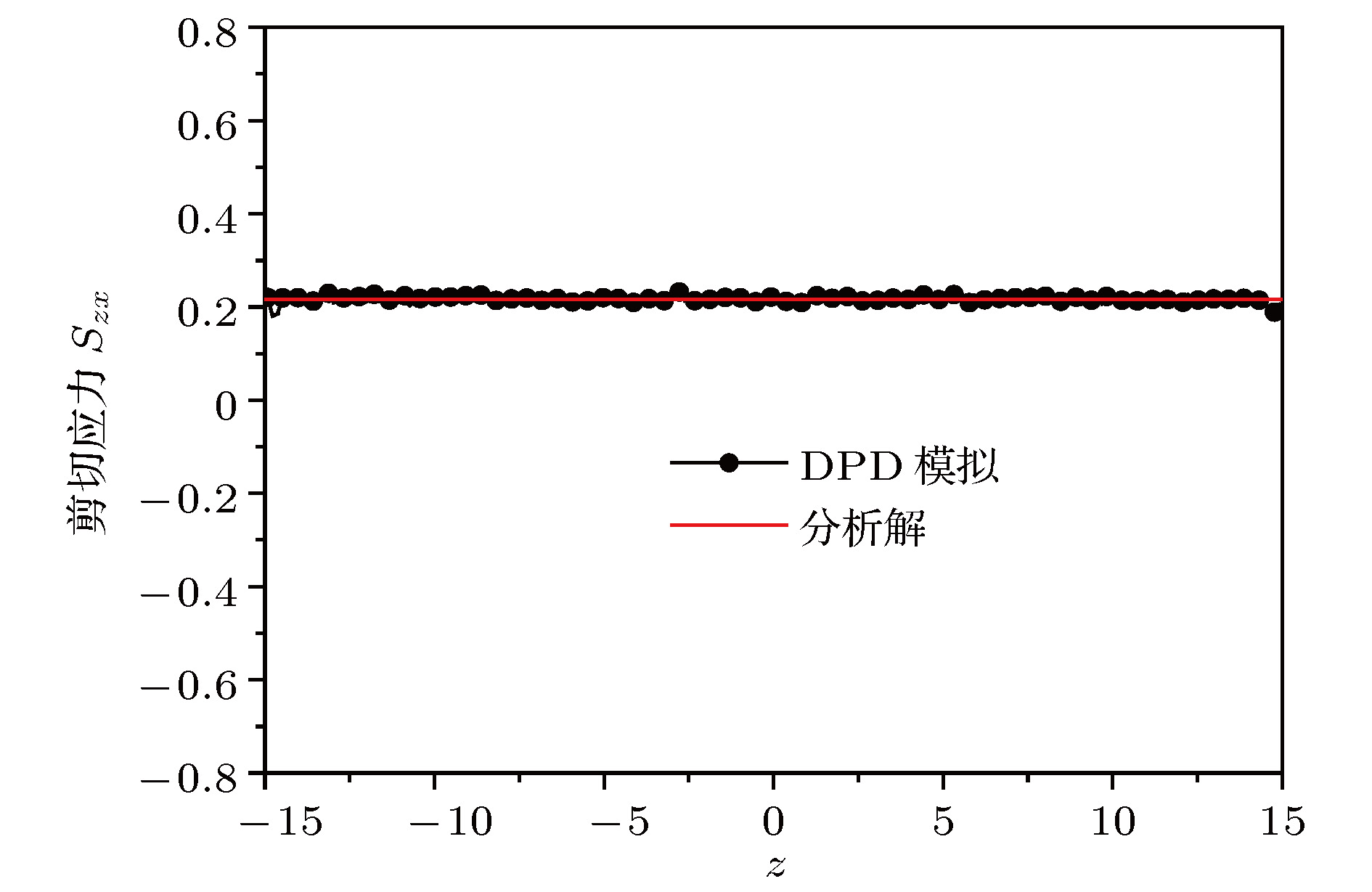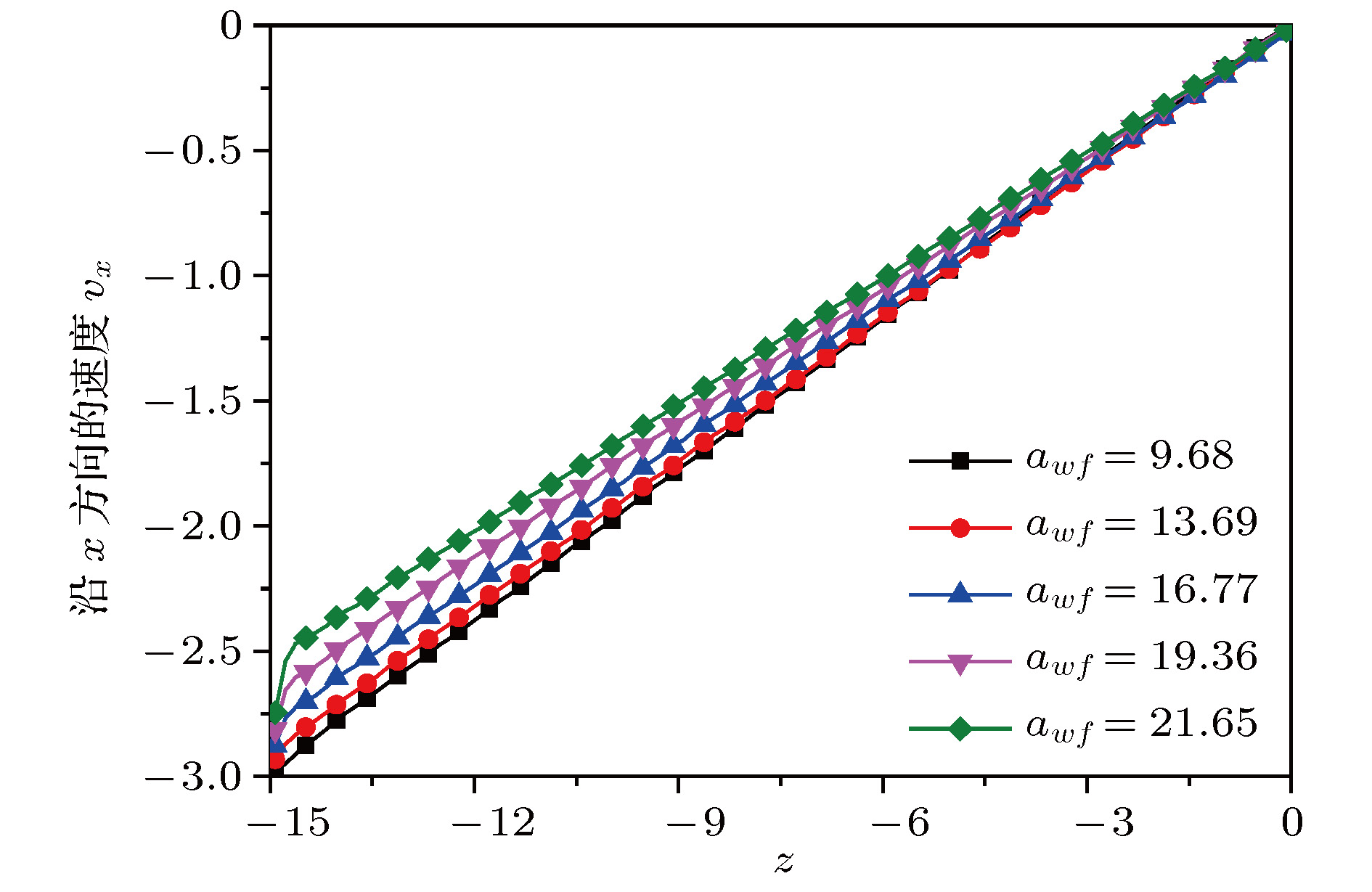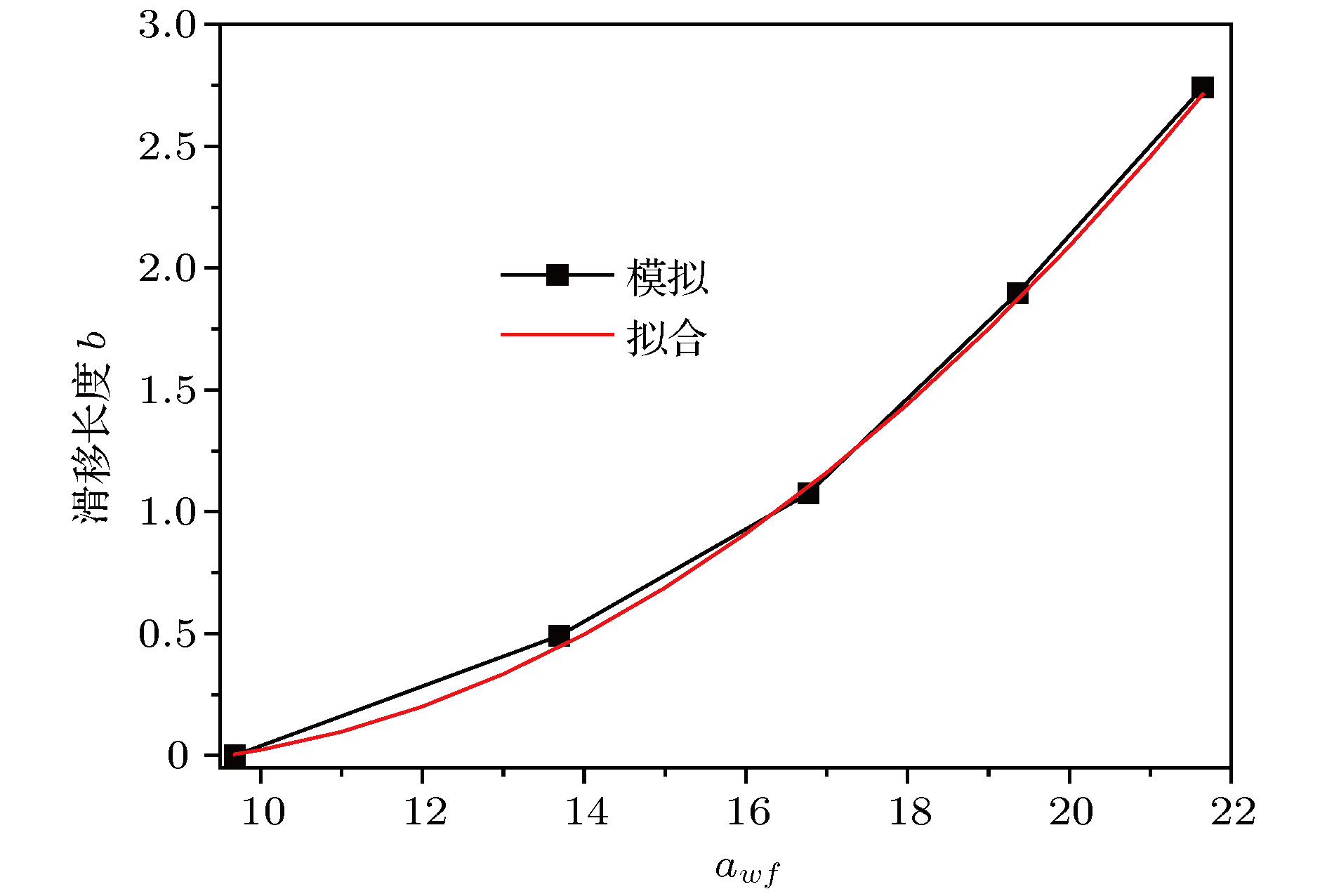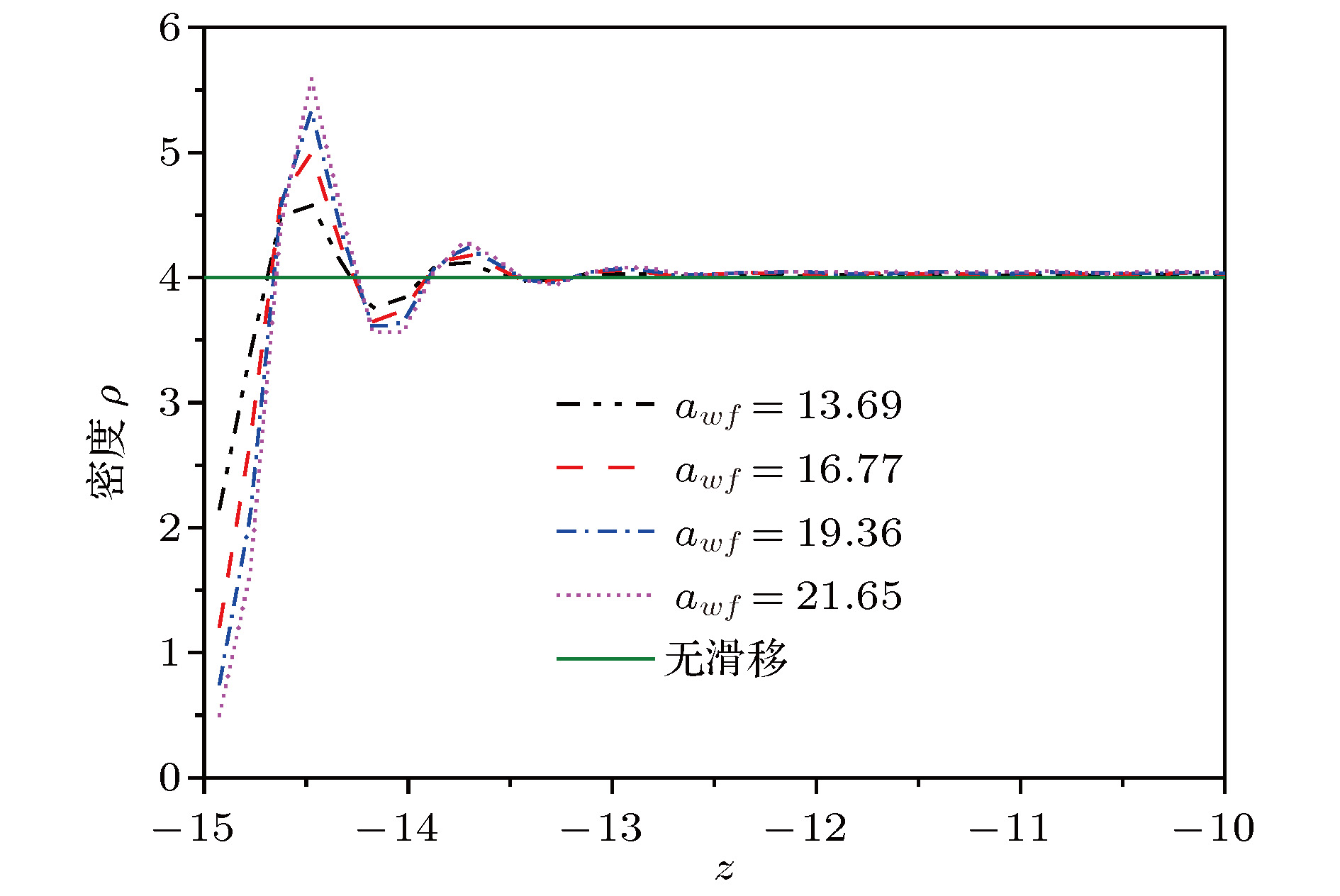-
The understanding of fluid slip over a hydrophobic surface is of great importance for reducing the drag for fluid flows. Dissipative particle dynamics (DPD) is used to investigate the mechanism of fluid slip at the solid-fluid interface in microchannels. A wall model adopting three layers of frozen particles is proposed for DPD simulation. In addition, a modified bounce-forward reflection is proposed to reintroduce fluid particles back into the fluid region when they " penetrate” into the wall region in the calculation due to the soft potential employed. Then the Couette flow is simulated by using the proposed wall model. The simulation results show that the no-slip or slip of the fluid at the wall can be achieved by adjusting parameter
$ {a_{\rm wf}}$ . The parameter$ {a_{wf}}$ represents the interaction between wall particles and liquid particles. Our simulation results show that the distributions of the velocity, density, temperature and shear stress compare well with the corresponding analytical solutions with$ {a_{\rm wf}} = 9.68$ , and there is no fluctuation of the fluid density near the wall. This indicates that the no-slip is obtained, and hence the wall is hydrophilic. With${a_{\rm wf}} > 9.68$ , the wall becomes hydrophobic and the fluid can slip at the wall. The wall becomes more hydrophobic with larger${a_{\rm wf}} $ , and the stronger hydrophobicity leads to greater slip. The slip velocity and slip length can be used to describe the fluid slip. According to the Navier slip boundary model, the slip velocity and slip length are determined by fitting a straight line (linear fitting) to the velocity profile in the central portion of the channel. The results show that the slip velocity or the slip length is a quadratic function of the parameter${a_{\rm wf}} $ , namely, the slip velocity or the slip length is a quadratic function of the contact angle. A physical mechanism of the fluid slip over hydrophobic surfaces is also proposed. The density profile is uniform for the no-slip condition, but there is a layer of low density fluid near the wall when the fluid can slip at the wall surface. This low density region can disrupt the momentum transfer between the wall and the fluid, which induces the fluid slip at the wall surface.-
Keywords:
- dissipative particle dynamics /
- hydrophobic surfaces /
- slip /
- low density region
[1] Feng L, Li S, Li Y, Li H, Zhang L, Zhai J, Song Y, Liu B, Jiang L 2002 Adv. Mater. 14 1857
 Google Scholar
Google Scholar
[2] Liu K S, Tian Y, Jiang L 2013 Prog. Mater. Sci. 58 503
 Google Scholar
Google Scholar
[3] Rothstein J P 2010 Annu. Rev. Fluid Mech. 42 89
 Google Scholar
Google Scholar
[4] Lauga E, Stone H A 2003 J. Fluid Mech. 489 55
 Google Scholar
Google Scholar
[5] Voronov R S, Papavassiliou D V, Lee L L 2006 J. Chem. Phys. 124 204701
 Google Scholar
Google Scholar
[6] Choi C, Westin K, Breuer K 2003 Phys. Fluids 15 2897
 Google Scholar
Google Scholar
[7] Lee C, Kim C J 2011 Langmuir 27 4243
[8] Tretheway D, Meinhart C 2002 Phys. Fluids 14 9
[9] Bhushan B, Wang Y, Maali A 2009 Langmuir 25 8117
 Google Scholar
Google Scholar
[10] Pit R, Hervet H, Leger L 2000 Phys. Rev. Lett. 85 980
 Google Scholar
Google Scholar
[11] 曹炳阳, 陈民, 过增元 2006 物理学报 55 5305
 Google Scholar
Google Scholar
Cao B Y, Chen M, Guo Z Y 2006 Acta Phys. Sin. 55 5305
 Google Scholar
Google Scholar
[12] Voronov R S, Papavassiliou D V, Lee L L 2007 Chem. Phys. Lett. 441 273
 Google Scholar
Google Scholar
[13] Voronov R S, Papavassiliou D V, Lee L L 2008 Ind. Eng. Chem. Res. 47 2455
 Google Scholar
Google Scholar
[14] 黄桥高, 潘光, 宋保维 2014 物理学报 63 054701
 Google Scholar
Google Scholar
Huang Q G, Pan G, Song B W 2014 Acta Phys. Sin. 63 054701
 Google Scholar
Google Scholar
[15] Zhang R L, Di Q F, Wang X L, Ding W P, Gong W 2012 J. Hydrodyn. 24 535
 Google Scholar
Google Scholar
[16] Cupelli C, Henrich B, Glatzel T, Zengerle R, Moseler M, Santer M 2008 New J. Phys. 10 043009
 Google Scholar
Google Scholar
[17] Tretheway D C, Meinhart C D 2004 Phys. Fluids 16 1509
 Google Scholar
Google Scholar
[18] Hoogerbrugge P J, Koelman J M V 1992 Europhys. Lett. 19 155
 Google Scholar
Google Scholar
[19] Espanol P, Warren P B 1995 Europhys. Lett. 30 191
 Google Scholar
Google Scholar
[20] Marsh C 1998 Ph. D Dissertation (Oxford: University of Oxford)
[21] Groot R D, Warren P B 1997 J. Chem. Phys. 107 4423
 Google Scholar
Google Scholar
[22] Liu M B, Liu G R, Zhou L W, Chang J Z 2015 Arch. Comput. Meth. Eng. 22 529
 Google Scholar
Google Scholar
[23] Liu M B, Meakin P, Huang H 2007 Phys. Fluids 19 033302
 Google Scholar
Google Scholar
[24] Wang Y, Chen S, Wu B 2017 Comput. Fluids 154 211
 Google Scholar
Google Scholar
[25] Revenga M, Zuniga I, Espanol P 1999 Comput. Phys. Commun. 121 309
[26] Willemsen S, Hoefsloot H, Iedema P 2000 Int. J. Mod. Phys. C 11 881
[27] Fan X J, Phan-Thien N, Yong N T, Wu X H, Xu D 2003 Phys. Fluids 15 11
 Google Scholar
Google Scholar
[28] Duong-Hong D, Phan-Thien N, Fan X 2004 Comput. Mech. 35 24
 Google Scholar
Google Scholar
[29] Pivkin I V, Karniadakis G E 2005 J. Comput. Phys. 207 114
 Google Scholar
Google Scholar
[30] Chen S, Phan-Thien N, Khoo B C, Fan X J 2006 Phys. Fluids 18 103605
 Google Scholar
Google Scholar
[31] 刘谋斌, 常建忠 2010 物理学报 59 7556
 Google Scholar
Google Scholar
Liu M B, Chang J Z 2010 Acta Phys. Sin. 59 7556
 Google Scholar
Google Scholar
[32] Rapaport D C 2004 The Art of Molecular Dynamics Simulation (Cambridge, UK: Cambridge University Press) p49-p60
[33] Liu M B, Chang J Z, Liu H T, Su T X 2011 Int. J. Comput. Meth. 8 637
 Google Scholar
Google Scholar
[34] Pivkin I V, Karniadakis G E 2006 Phys. Rev. Lett. 96 206001
 Google Scholar
Google Scholar
[35] Fedosov D A, Pivkin I V, Karniadakis G E 2008 J. Comput. Phys. 227 2540
 Google Scholar
Google Scholar
-
表 1 不同排斥力系数
${a_{\rm wf}}$ 时拟合的速度分布及对应的滑移速度和滑移长度Table 1. The linear fit velocity profiles, slip velocity and slip length with respect to different
${a_{\rm wf}}$ .${a_{\rm wf}}$ 拟合的速度直线 滑移速度 滑移长度 13.69 ${v_x} = 0.1936z - 0.0009$ 0.0951 0.4912 16.77 ${v_x} = 0.1864z - 0.0036$ 0.2004 1.0751 19.36 ${v_x} = 0.1778z + 0.0044$ 0.3374 1.8976 21.65 ${v_x} = 0.1691z + 0.0002$ 0.4637 2.7422 9.68(无滑移) ${v_x} = 0.2z$(理论解) 0 0 -
[1] Feng L, Li S, Li Y, Li H, Zhang L, Zhai J, Song Y, Liu B, Jiang L 2002 Adv. Mater. 14 1857
 Google Scholar
Google Scholar
[2] Liu K S, Tian Y, Jiang L 2013 Prog. Mater. Sci. 58 503
 Google Scholar
Google Scholar
[3] Rothstein J P 2010 Annu. Rev. Fluid Mech. 42 89
 Google Scholar
Google Scholar
[4] Lauga E, Stone H A 2003 J. Fluid Mech. 489 55
 Google Scholar
Google Scholar
[5] Voronov R S, Papavassiliou D V, Lee L L 2006 J. Chem. Phys. 124 204701
 Google Scholar
Google Scholar
[6] Choi C, Westin K, Breuer K 2003 Phys. Fluids 15 2897
 Google Scholar
Google Scholar
[7] Lee C, Kim C J 2011 Langmuir 27 4243
[8] Tretheway D, Meinhart C 2002 Phys. Fluids 14 9
[9] Bhushan B, Wang Y, Maali A 2009 Langmuir 25 8117
 Google Scholar
Google Scholar
[10] Pit R, Hervet H, Leger L 2000 Phys. Rev. Lett. 85 980
 Google Scholar
Google Scholar
[11] 曹炳阳, 陈民, 过增元 2006 物理学报 55 5305
 Google Scholar
Google Scholar
Cao B Y, Chen M, Guo Z Y 2006 Acta Phys. Sin. 55 5305
 Google Scholar
Google Scholar
[12] Voronov R S, Papavassiliou D V, Lee L L 2007 Chem. Phys. Lett. 441 273
 Google Scholar
Google Scholar
[13] Voronov R S, Papavassiliou D V, Lee L L 2008 Ind. Eng. Chem. Res. 47 2455
 Google Scholar
Google Scholar
[14] 黄桥高, 潘光, 宋保维 2014 物理学报 63 054701
 Google Scholar
Google Scholar
Huang Q G, Pan G, Song B W 2014 Acta Phys. Sin. 63 054701
 Google Scholar
Google Scholar
[15] Zhang R L, Di Q F, Wang X L, Ding W P, Gong W 2012 J. Hydrodyn. 24 535
 Google Scholar
Google Scholar
[16] Cupelli C, Henrich B, Glatzel T, Zengerle R, Moseler M, Santer M 2008 New J. Phys. 10 043009
 Google Scholar
Google Scholar
[17] Tretheway D C, Meinhart C D 2004 Phys. Fluids 16 1509
 Google Scholar
Google Scholar
[18] Hoogerbrugge P J, Koelman J M V 1992 Europhys. Lett. 19 155
 Google Scholar
Google Scholar
[19] Espanol P, Warren P B 1995 Europhys. Lett. 30 191
 Google Scholar
Google Scholar
[20] Marsh C 1998 Ph. D Dissertation (Oxford: University of Oxford)
[21] Groot R D, Warren P B 1997 J. Chem. Phys. 107 4423
 Google Scholar
Google Scholar
[22] Liu M B, Liu G R, Zhou L W, Chang J Z 2015 Arch. Comput. Meth. Eng. 22 529
 Google Scholar
Google Scholar
[23] Liu M B, Meakin P, Huang H 2007 Phys. Fluids 19 033302
 Google Scholar
Google Scholar
[24] Wang Y, Chen S, Wu B 2017 Comput. Fluids 154 211
 Google Scholar
Google Scholar
[25] Revenga M, Zuniga I, Espanol P 1999 Comput. Phys. Commun. 121 309
[26] Willemsen S, Hoefsloot H, Iedema P 2000 Int. J. Mod. Phys. C 11 881
[27] Fan X J, Phan-Thien N, Yong N T, Wu X H, Xu D 2003 Phys. Fluids 15 11
 Google Scholar
Google Scholar
[28] Duong-Hong D, Phan-Thien N, Fan X 2004 Comput. Mech. 35 24
 Google Scholar
Google Scholar
[29] Pivkin I V, Karniadakis G E 2005 J. Comput. Phys. 207 114
 Google Scholar
Google Scholar
[30] Chen S, Phan-Thien N, Khoo B C, Fan X J 2006 Phys. Fluids 18 103605
 Google Scholar
Google Scholar
[31] 刘谋斌, 常建忠 2010 物理学报 59 7556
 Google Scholar
Google Scholar
Liu M B, Chang J Z 2010 Acta Phys. Sin. 59 7556
 Google Scholar
Google Scholar
[32] Rapaport D C 2004 The Art of Molecular Dynamics Simulation (Cambridge, UK: Cambridge University Press) p49-p60
[33] Liu M B, Chang J Z, Liu H T, Su T X 2011 Int. J. Comput. Meth. 8 637
 Google Scholar
Google Scholar
[34] Pivkin I V, Karniadakis G E 2006 Phys. Rev. Lett. 96 206001
 Google Scholar
Google Scholar
[35] Fedosov D A, Pivkin I V, Karniadakis G E 2008 J. Comput. Phys. 227 2540
 Google Scholar
Google Scholar
Catalog
Metrics
- Abstract views: 13141
- PDF Downloads: 99
- Cited By: 0




















 DownLoad:
DownLoad:
